Cup / Goblet / Porringer
Cup / Goblet / Porringer
Drinking plays an important role in the enjoyment of life. Browse our collection of sterling silver cups, goblets, beakers, porringers and specialist drinking vessels. An excellent range of early silver examples for the collector which are ideal for practical use and make a perfect gift.
Cups and Trophies, Goblets & Chalices, Beakers & Tumbler Cups
Coconut Cups and Quaiches, Porringers and Bleeding Bowls, Stirrup and Wager Cups
Silver Cups and Trophies. Large size goblets and 2 handled cups are often given as trophy prizes and many have interesting presentation inscriptions. These cups are often used as wine coolers and make fascinating conversation pieces.
Silver Wine Goblets were popular in England during the 17th century until they were superseded by glass drinking vessels in the late 1600s. Silver goblets made a comeback in the mid 18th century and have remained popular ever since. Church communion Chalices can be found dating back to as early as 1560. They sometimes have a cover which doubles as a paten.
Antique Silver Beakers date back to the early 1600s in Europe. They have remained popular up until the present day and are generally of a simple flared form. Sometimes double beakers are found which fit together in the shape of a barrel.
The “Camp Canteen”, dating from the late 17th century onwards, is a travelling set consisting of a beaker fitted inside with cutlery, condiments and possibly a corkscrew.
Silver Tumbler Cups were made from the mid 17th century onwards. They are made from thick gauge sheet silver which was hammered up so that the sides become thinner towards the top and the rounded base would have the greater weight. When they are knocked over they will automatically right themselves. A very useful drinking cup to use onboard ship.
Antique Silver Mounted Coconut Cups. Coconuts were prized in early times for their healing powers and drinking vessels were often formed from them. The coconut cup is a variety of standing cup, made and used in Europe in the 15th and 16th Century, with a revival in Georgian England. Usually they have a pedestal foot or 3 ornamental feet and are mounted in silver or Old Sheffield plate. Many coconuts were carved on board ship by the sailors (or prisoners of war).
Silver Quaiches. Used in Scotland for centuries, the quaiche is a shallow cup with two, or even three, side handles used to drink spirits such as whiskey or brandy. It is a social drinking vessel, symbolic of friendship and trust, which one person would pass to another with both hands (which would render them incapable of holding a secret weapon). In the centre of the basin usually lies a large coin or medallion, often engraved with a coat of arms, a set of initials, a motto, or a toast such as ‘cheers!’ Over the years the quaiche has become a traditional gift at special occasions such as weddings and christenings.
Porringers and Bleeding Bowls. In the past, people from all levels of society took their food in forms unfamiliar today. Everyday nourishment depended heavily on eggs, milk, oats and grains. Ale, sack mead, wine, spices, sultanas and sugar were added for flavor. The gruel, porridge, potage (soup), caudle and other sloppy warm mixtures were partially drunk and partially eaten with a spoon. They were served in 2 handled cups, often with a cover to keep it warm.
Silver Porringers are two handled bowls and some have a cover. They can also be known as caudle cups although the origin of the porringer was for porridge and the caudle cup was for a type of broth. From the eighteenth century onwards, porringers and cups and covers were used mainly as centrepieces or ornaments. In recent times they have seen a resurgence in popularity for drinking and on the dining table. They make a very attractive baby gift.
Silver Bleeding Bowls may have been used for medical purposes however many people think that these shallow bowls were more likely to have been eating vessels, especially for feeding the sick.
Brandy became popular during the 17th century and was consumed from small, lightweight silver Brandy Cups. This spirit was introduced by Dutch traders from Southern France and Spain and was orginally known as “Brandewijn” or “Hottwater”. It was the cheapest alcoholic drink because, unlike wine, ale and cider, it was not taxed until the 1690’s.
Figural Cups, Stirrup Cups and Wager Cups
Silver Stirrup Cups in silver didn’t become popular until the mid 18th century. The name derives from a cup of wine or other alcoholic drink offered to a person on horseback who is about to depart on a journey (with one’s feet in the stirrups). This term is now more associated with the cup used at the traditional fox hunt. The stirrup cup is usually ornamental and often in the form of a fox head.
Silver Wager Cups.
Marriage cups. These highly collectible silver double drinking vessels are also known as marriage cups. The idea is to drink the contents of the large cup (the lady’s skirt) without spilling the drink inside the small cup. The bride would drink from the small cup, the groom from the large cup.
Windmill cups were used as a drinking game. First fill the cup up with a liquor of choice and spin the windmill sails (either by hand or by blowing the horn). The challenge is to drink the contents of the cup before the sails stop. The clock hands on some windmills also revolve with the sails and a penalty would be due depending on the number where the hand (pointer) stopped.”
-

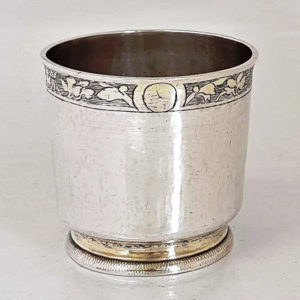
Circa 1550
Leonhard Bram
9788 Antique Swiss Silver Beaker
Sold
An exceptionally early drinking cup dating from the 16th century. This parcel gilt beaker has a cylindrical tumbler form and stands on a shallow foot. The cup still retains the original hand beaten finish. There is a gilded band of decoration around the top with foliate scrolls and roundels on a hatched background. The foot has a gilt band and feather decorated border. The underside retains traces of the old, blobby mercury solder used in the original manufacture over 450 years ago. Contains 150 ml. Weight 79 grams, 2.4 troy ounces. Height 6.4cm. Diameter 6.9cm. Stamped underneath with Swiss silver marks for Zurich, Switzerland. Maker Leonhard Bram. Circa 1550. Ref: Eva Losel’s book on Zurich Goldsmiths pages 164 and 360 – see images.
-

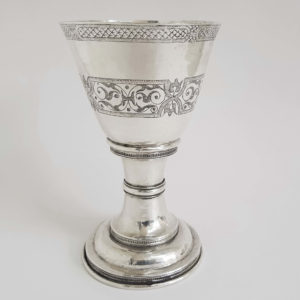
Circa 1567
10185 Elizabeth I Antique Silver Chalice
Sold
A rare 16th century silver chalice with paten. The cup follows the standard design for Elizabethan communion cups with straight tapering sides, very slightly flared at the top, on a spreading foot. Decorated with broad bands of hatched engraving around the centre and top rim, and ornamental wires to the stem and foot. The cover has a matching decoration and a date of 1567. This cup is of excellent quality and weighs heavy in the hand. Contains 240 ml. Weight of chalice and paten 338 grams, 10.8 troy ounces. Chalice dimensions – height 16.1cm, diameter of top 9.9cm, foot 8.7cm. Unmarked silver. English probably provincial. Circa 1567.
-

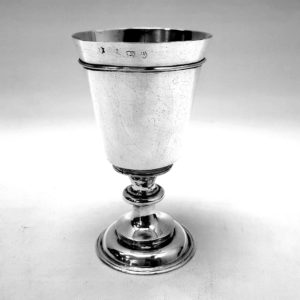
1568
William Dyxson
10179 Elizabeth I Antique Silver Chalice
Sold
A rare early English silver chalice dating to the reign of Elizabeth I. This cup follows the standard design for Elizabethan communion cups and is most likely to have been made from pre-reformation silver. Of very plain form, the straight tapering sided bowl has a circular band below the rim, and simple reeded wire ornamentation has been applied to the stem and foot. This cup would originally have had a cover (paten). Weight 139 grams, 4.4 troy ounces. Height 14cm. Diameter – top 8.1cm, foot 6.8cm. London 1568. Maker William Dyxson. Sterling silver. 16th century.
-

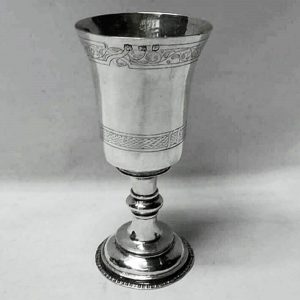
1569
7543 Elizabeth I Silver Chalice dated 1569
Sold
An extremely rare early English chalice dating to the reign of Elizabeth I. It is quite remarkable to find a piece of silver of such an early date and especially in such good condition. This cup follows the standard design for Elizabethan communion cups and is most likely to have been made from pre-reformation silver. It has a flared top and would originally have had a cover (paten). The engraved arabesques to the body are typical for the period. The foot wire has stamped ornament of tongue and dart. Charming hand beaten finish as you’d expect at this date. Weight 231 grams, 7.4 troy ounces. Height 18.5 cms. Diameter – top 9 cms, foot 7.75 cms. Extremely good silver marks for London 1569. The makers mark letter “A” was entered in 1564/5 (Jacksons page 96). It’s very rare for marks of this period to have a name associated with it*.
-

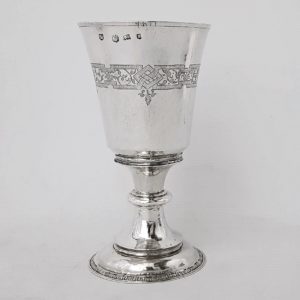
1569
Henry Sutton
9853 Elizabeth I Silver Chalice
Sold
A rare early English chalice dating to the reign of Elizabeth I. A very early date and in very good condition. With straight tapering sides, slightly flared at the top, and would originally have had a cover (paten). Hand beaten finish as you’d expect at this date. The single hatched band of decoration is well executed and the definition is very good. Around the top rim are 3 engraved marks and one of these has the date “1600”. The foot wire has stamped ornament of tongue and dart, typical of the period, and applied wire ornament to the stem. Contains 380 ml. Weight of chalice 292 grams, 9.3 troy ounces. Chalice dimensions – height 18.2cm, diameter of top 9.8cm. Extremely good silver marks for London 1569. Maker “HS” is possibly the Henry Sutton listed in Jackson’s Gold & Silver Marks as a known maker of communion cups. Sterling silver.
-

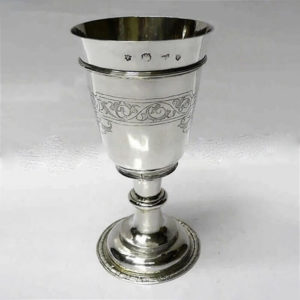
1570
William Dyxson
6399 Elizabeth I Silver Chalice dated 1570
Sold
An extremely rare early English chalice dating to the reign of Elizabeth I. It is quite remarkable to find a piece of silver of such an early date and especially in such excellent condition. This cup follows the standard design for Elizabethan communion cups and is most likely to have been made from pre-reformation silver. It would originally have had a cover (paten). The engraved arabesques to the body are typical for the period. The foot wire has stamped ornament of tongue and dart. Weight 257 grams, 8.2 troy ounces. Height 18 cms. Diameter – top 9 cms, foot 8.5 cms. Extremely good silver marks for London 1570. Maker William Dyxson.
-

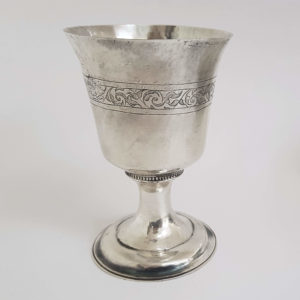
Circa 1570
10183 Elizabeth I Antique Silver Chalice
Sold
A small 16th century silver chalice with paten. The cup, following the standard design for Elizabethan communion cups, has straight tapering sides, slightly flared at the top, on a spreading foot. Decorated with a single hatched band of engraving around the centre and an ornamental wire to the top of the stem. The cover is of simple, plain design. Contains 145 ml. Weight of chalice and paten 122 grams, 3.9 troy ounces. Chalice dimensions – height 11.5cm, diameter of top 7.2cm, foot 7cm. Unmarked silver. Probably provincial. Circa 1570.
-

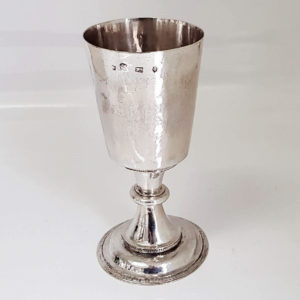
1571
Andrew Kemp
9750 Elizabeth I Silver Chalice
Sold
A rare early English chalice dating to the reign of Elizabeth I. A very early date and in very good condition. This cup follows the standard design for Elizabethan communion cups and is most likely to have been made from pre-reformation silver. It has straight tapering sides and would originally have had a cover (paten). Charmingly hand beaten finish as you’d expect at this date. Very plain design. The foot wire has stamped ornament of tongue and dart, typical of the period, and further wire ornament is applied to the stem. Contains 320 ml. Weight 248 grams, 7.9 troy ounces. Height 18.5cm. Diameter of top 8.6cm. Extremely good silver marks for London 1571. Maker Andrew Kemp (Jackson’s Gold & Silver Marks page 93), known for making communion cups. Sterling silver.
-

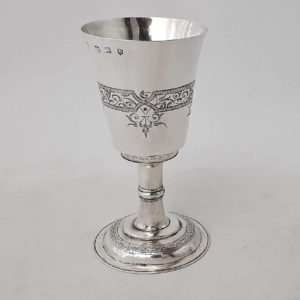
1571
James Feake
9918 Elizabeth I Silver Chalice
Sold
A rare early English chalice dating to the reign of Elizabeth I. A very early date and in very good condition. With straight tapering sides, slightly flared at the top, and would originally have had a cover (paten). Hand beaten finish as you’d expect at this date. The single hatched band of decoration is well executed and the definition is very good. There is applied wire ornament to the stem, the foot has a second band of hatched engraving. Contains 180 ml. Weight of chalice 190 grams, 6.1 troy ounces. Chalice dimensions – height 15.3cm, diameter of top 7.7cm. Extremely good silver marks for London 1571. Maker probably James Feake. Sterling silver.
-

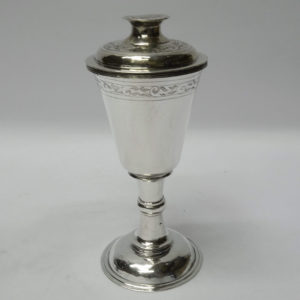
1573
9044 Elizabeth I Silver Chalice
Sold
An extremely rare early English chalice with its matching paten dating to the reign of Elizabeth I. It is quite remarkable to find a piece of silver of such an early date and especially in such excellent condition. This cup follows the standard design for Elizabethan communion cups and is most likely to have been made from pre-reformation silver. The hatched decorative band below the top edge of the cup is typical for the period. Simple foot wires around the base and scratched owners initials. The paten has a similar band of hatched ornament and has the date 1574 which is consistent with the date of manufacture. Total weight 188 grams, 6 troy ounces. Height 15 cms (cup), 18 cms (with top). Diameter of top 9.4 cms. Extremely good silver marks for London 1573. Makers mark “IP” (Jacksons page 95) a known maker of communion cups between 1565-79.
-

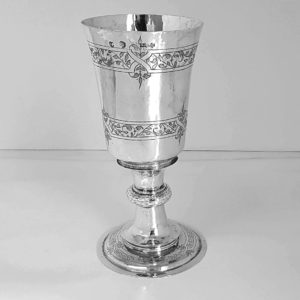
1573
9768 Elizabeth I Silver Chalice
Sold
A rare early English silver wine cup dating to the reign of Elizabeth I. A very early date and in very good condition. This cup follows the standard design for Elizabethan communion cups and is most likely to have been made from pre-reformation silver. It has straight tapering sides, slightly flared at the top, and has a removable cover (paten). Charmingly hand beaten finish as you’d expect at this date. The hatched decorative bands below the top edge of the cup are typical for the period, repeated to the foot. The paten has a similar band of hatched ornament and bears the date 1575 which is consistent with the date of manufacture. Contains 350 ml. Weight of chalice 270 grams, 8.6 troy ounces. Weight of paten 94 grams, 3.0 troy ounces. Chalice dimensions – height 19.6cm, diameter of top 9cm. Extremely good silver marks for London 1573. Maker “IP” listed in Jackson’s Gold & Silver Marks as a known maker of communion cups. Sterling silver.
-

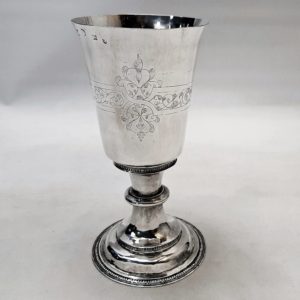
1573
Andrew Kemp
10240 Elizabeth I Antique Silver Chalice
Sold
A rare early English chalice dating to the reign of Elizabeth I. This cup has the standard design for Elizabethan communion cups with straight tapering sides and slightly flared top. It’s most likely to have been made from pre-reformation silver and has the lovely hand beaten finish you’d expect at this date. The single hatched band of arabesque decoration is well executed and the definition is very good. There is applied wire ornament to the stem and foot. Traces of gilding to the bowl. The cup would originally have had a cover (paten). Contains 400 ml. Weight of chalice 256 grams, 8.2 troy ounces. Height 20.2cm, diameter of top 9.9cm. London 1573. Maker Andrew Kemp. Sterling silver.
-

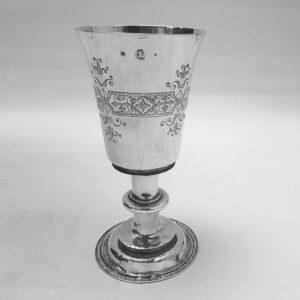
Circa 1574
Lawrence Stratford
10321 Elizabeth I Antique Silver Chalice
Sold
Originating from the English provincial town of Dorchester in Dorset, this fine early English chalice dates to the reign of Elizabeth I. It has the standard design for Elizabethan communion cups with straight tapering sides and a slightly flared top; with wire ornament applied to the stem and hammered egg and dart frieze to the foot. The beautifully hatched decorative bands below the top edge of the cup are typical for the period, they are well executed and with good definition. Most likely this cup has been made from pre-reformation silver and it has the lovely hand beaten finish you’d expect at this date. The removable cover (paten) bears the date of 1574. Superb antique colour.
Contains 250 ml. Chalice weight 231 grams, 7.4 troy oz. Height 20.2cm, diameter of top 9.9cm. Cover weight 55 grams, 1.7 troy oz. Height 2.4cm, diameter 9cm. London c.1574.
Maker’s mark only for Lawrence Stratford. Sterling silver. 16th century. -

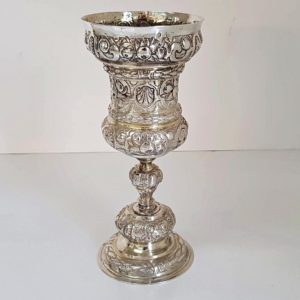
Circa 1600
David Lauer
9776 Antique Nuremberg Silver Goblet
Sold
An excellent quality antique German renaissance silver drinking cup of bell shaped form. Highly decorative and embossed throughout with shells, fruits and other motifs on a matted background. Traces of the original gilt inside and out. Owners initials are etched on the underside. Contains 220 ml. Weight 228 grams, 7.3 troy ounces. Height 19.2 cm. Diameter 8.3 cm. Stamped on the rim and foot with German silver stamps for Nurnburg circa 1600. Maker David Lauer, working 1583-1609.
-

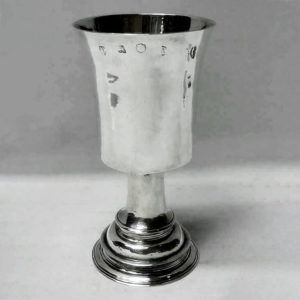
1610
7545 Antique James I Silver Chalice dated 1610
Sold
A rare early English sterling silver chalice dating to the reign of James I. Over 400 years old and in very good condition. Plain design with a flared top and stepped pedestal foot. This would originally have had a cover (paten). Uninscribed. Excellent colour. Charming hand beaten finish as you’d expect from this period. Contains 220 ml. Weight 160 grams, 5.1 troy ounces. Height 15 cms. Diameter – top 8 cms, foot 7 cms. Extremely good silver marks for London 1610.
-

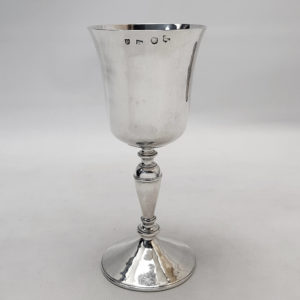
1612
Benjamin Francis
10180 James I Antique Silver Wine Cup
Sold
A rare early English sterling silver goblet dating to the reign of James I. 400 years old and in very good condition. Plain tapering form over a baluster column and simple pedestal foot. This cup is an outstanding piece of antique silver in every way. Large size. Excellent patina. Heavy weight and gauge of silver. Charming hand beaten finish as you’d expect from this period. Contains 350 ml. Weight 286 grams, 9.1 troy ounces. Height 22cm. Diameter of top 9.6cm, foot 8.1cm. London 1612. Maker possibly Benjamin Francis, a known cup maker of the period (see Jackson’s “Gold & Silver Marks” page 109 and also Dr David Mitchell’s “Silversmiths in Elizabethan and Stuart London”). 17th century.
-

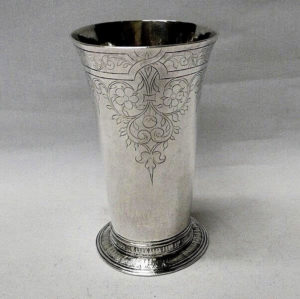
1614
Francis Saunders
8492 Antique James I Silver Beaker
Sold
A rare early English antique sterling silver beaker of tall, plain design. At 6 inches the height is in keeping with its early date; mid 17th century beakers were shorter, about 3 to 4 inches high. Around the top there is a band of hatched foliate decoration; this was used from the Elizabethan period up to about 1620. The foot is decorated with a stamped egg and dart ornamentation typical of this period. Contains 400 ml. Weight 224 grams, 7.2 troy ounces. Height 14.8 cms, 6 inches. Diameter of top 8.6 cms. London 1614. Maker “SF” or “FS” (Jacksons page 107, Pickford edition). Probably “FS” for Francis Saunders (see David Mitchell’s Silversmiths in Elizabethan and Stuart London. *It’s very rare for marks of this period to have a name associated with it.
-

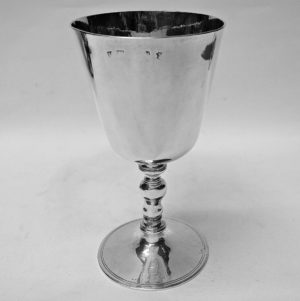
1617
Francis Saunders
9032 Antique James I Silver Wine Cup
Sold
A rare early English sterling silver goblet dating to the reign of James I. 400 years old and in very good condition. Plain tapering form over a baluster column and simple pedestal foot. This cup is an outstanding piece of antique silver in every way. Large size. Excellent patina. Heavy weight and gauge of silver. Fully marked in a straight line just below the rim and has the lion passant and scratch weight on the underside of the foot. Charming hand beaten finish as you’d expect from this period. Contains 500 ml. Weight 306 grams, 9.8 troy ounces. Height 20 cms. Diameter of top 10.7 cms. London 1617. Makers mark either “FS” or “SF”, a known cup maker of the period – see Jacksons page 107, probably Francis Saunders free c.1608 (attribution by Dr David Mitchell in “Silversmiths in Elizabethan and Stuart London”).
-

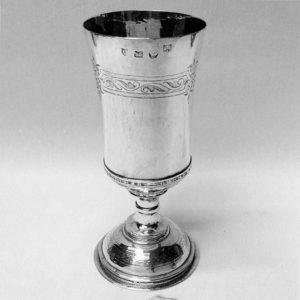
1617
8014 Antique James I Silver Chalice
Sold
A rare early English sterling silver chalice dating to the reign of James I. Over 400 years old and in very good condition. Plain form with a flared top and shaped pedestal foot. The outside of the bowl has a broad hand engraved design with scrolls and leaves. The pedestal foot is engraved with the much used “hit and miss” decoration which consists of parallel lines of spaced dashes. Uninscribed. Excellent colour. Charming hand beaten finish as you’d expect from this period. Contains 300 ml. Weight 198 grams, 6.3 troy ounces. Height 17.5 cms. Diameter – top 7.25 cms, foot 8 cms. Extremely good silver marks for London 1617. Makers mark “IV” – see Jacksons page 107, (*it’s very rare for marks of this period to have a name associated with it). There would originally have been a cover (paten).
-

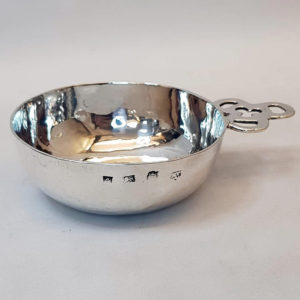
1625
Robert Profit
9989 Charles I Antique Silver Bowl
Sold
An extremely early date. A rare antique silver porringer (or bleeding bowl) of plain circular form. The straight sided shape with a simple rim is the earliest type and in keeping with the early date. Small proportions and very charming with the original hand beaten finish. A useful serving bowl, handy for nuts and sweets. Prick marked on the edge of the rim with the initials “MC”. Weight 108 grams, 3.4 troy ounces. Diameter 10.3cm. Height 3.5 cm. Spread 14cm. London 1625. Maker “RP” possibly Robert Profit (David Mitchell’s “Silversmiths in Elizabethan and Stuart London”).
-

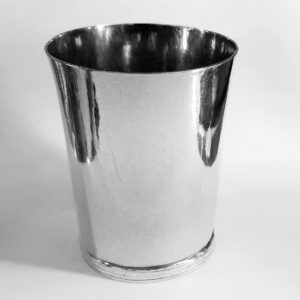
1626
Richard Blackwell
9968 Charles I Antique Silver Beaker
Sold
Dating from the early 1600’s. An early English antique silver beaker of plain tapering design with simple foot wires. Lovely plain form. Excellent patina and hand beaten finish. Contains 250 ml. Weight 120 grams, 3.8 troy ounces. Height 8.9 cm. Diameter 7.0cm (top), 6.0cm (base). London 1626. Sterling silver. Maker’s mark “probably” Richard Blackwell the Elder – see David Mitchell’s “Silversmiths in Elizabethan and Stuart London”.
-

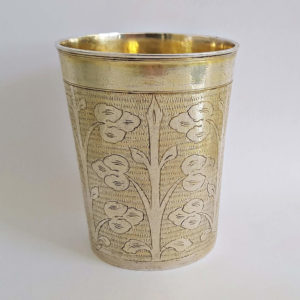
1628 - 1635
Wenzel Zeideler
9988 Antique German Silver Beaker
Sold
An early Leipzig silver stipple ground beaker of tapering form. Original gilt finish. Hand engraved to the body is a charming design of a tree with outspread branches and large leaves like table tennis bats. Contains 190 ml. Weight 109 grams, 3.5 troy ounces. Height 8.3cm. Diameter 6.7cm (top), 5.2cm (base). Leipzig 1633-1635 Maker Wenzel Zeideler. Circa 1628-30. Marks. Stamped underneath with German silver marks for Leipzig.
-

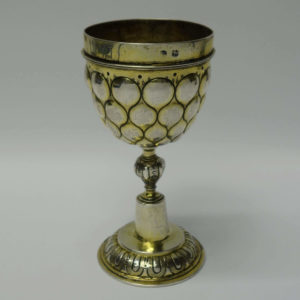
Circa 1630
Michel Mader
8953 Antique German Goblet
Sold
Of Jewish interest. A charming early antique Nurnberg chalice of circular form with ovoid embossed decoration and original gilt finish (worn). Contains 180 ml. Weight 135 grams, 4.3 troy ounces. Height 14cm. Diameter 7.2cm (top), 6.5cm (foot). Stamped with German silver marks for Nurnberg. Maker Michel Mader. Circa 1630.
-

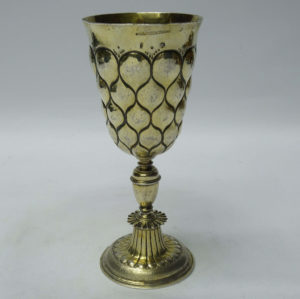
Circa 1630
Augsburg
9035 Antique Augsburg Silver Goblet
Sold
A good antique German silver wine cup of tapering form over a shaped pedestal and flared foot. Pineapple decoration. Original fire gilt. Contains 165 ml. Weight 169 grams, 5.4 troy ounces. Height 16.6 cms. Diameter 6.9 cms. Stamped on both the rim and foot with the Augsburg town mark, makers mark and assay scrape. Maker David Roll. Circa 1630.
-

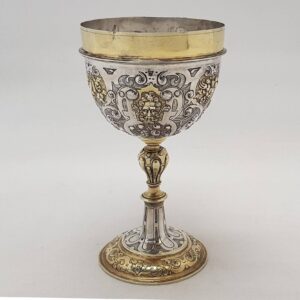
Circa 1630
10311 17th Century German Antique Silver Wine Cup
Sold
A decorative continental parcel gilt silver goblet dating to the beginning of the 1600’s. The cup is embossed and chased with the typical decoration of the period of masks, flowers and strapwork. Contains 290ml. Weight 176 grams, 5.6 troy ounces. Height 16.6cm. Diameter 9.2cm. Unmarked silver. Probably German. Circa 1630.
-

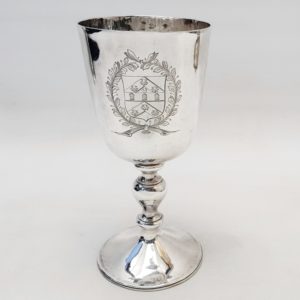
1631
10256 Charles I Antique Silver Cup
Sold
A superb early English silver wine cup of very plain form with a cast baluster stem and spreading foot. This large goblet has an excellent patina, good weight, and sits very well in the hand. To the front is a well-executed armorial for Dr Thomas Eden, hand engraved, the style is typical of the Charles I period with the shield within a laurel-wreath. This is an outstanding piece of antique silver in every way. Contains 430 ml. Weight 326 grams, 10.4 troy ounces. Height 19.8cm. Diameter 9.2cm (top), 9cm (foot). London 1631. Maker “HM”. Sterling silver. 17th century.
-

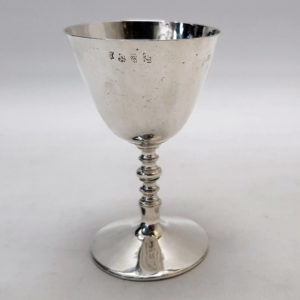
1632
Pelican in her piety
10197 Antique Norwich Silver Wine Cup
Sold
An exceptionally rare piece of early East Anglian provincial silver dating to the reign of Charles I. The silver cup, of plain simple form, has a tapering bowl with cast baluster stem and spreading foot. Contains 120ml. Weight 118 grams, 3.7 troy ounces. Height 13cm. Diameter 7.8 (top), 6.8cm (foot). Norwich 1632. Maker’s mark “Pelican in her Piety”. Sterling silver. 17th century.
-

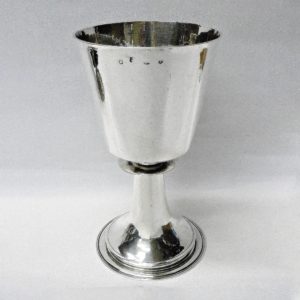
1635
8338 Antique Charles I Silver Chalice
Sold
A rare early English sterling silver cup dating to the reign of Charles I. Nearly 400 years old and in very good condition. Plain tapering form on a shaped pedestal foot. Hand engraved to the front is a prick dot cartouche containing the letters ‘SE’, probably the original owner’s initials. This cup is an outstanding piece of antique silver in every way. Large size. Excellent patina. Heavy weight and gauge of silver. Fully marked in a straight line just below the rim and has the lion passant on the underside of the foot. Charming hand beaten finish as you’d expect from this period. Contains 850 ml. Weight 558 grams, 17.9 troy ounces. Height 23cm. Diameter of top 13cm. London 1635. Escallop shell makers mark.
-

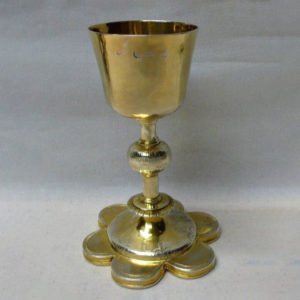
1635
Richard Blackwell
8364 Antique Charles I Silver Chalice
Sold
A rare early English sterling silver chalice dating to the reign of Charles I. Nearly 400 years old and in very good condition. Gilt silver. Plain form with a tapering bowl and hexafoil foot. The stem and foot have hand engraved decoration, the foot with a crucifixion scene. Excellent colour and workmanship. Contains 150 ml. Weight 303 grams, 9.7 troy ounces. Height 17cm. Diameter – top 7.5cm, foot 11.5cm. Good silver marks for London 1635. Maker’s mark probably “RB over an escallop” – see Jacksons (Pickford edition) page 117. Probably Richard Blackwell the elder – see David Mitchell’s Silversmiths in Elizabethan and Stuart London*
-

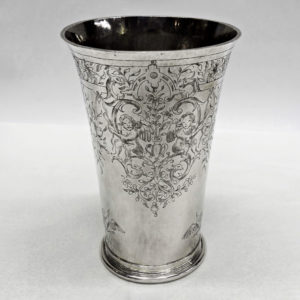
1635 - 1658
9285 Antique Dutch Silver Beaker
Sold
An antique silver beaker of tall tapering form with a flared rim. Large size and good gauge silver. The cup has fine quality engraving of cherubs and garlands of fruit surrounded by foliate scrolls and classical motifs. The base still has an old Dutch stock label. Weight 462 grams, 14.8 troy ounces. Height 19.2 cm. Diameter 12.5 cm (top), 9.2 cm (base). Stamped underneath with Netherlands silver marks. The makers mark, a lion, is probably Dordrecht, 1635 or 1658.
-

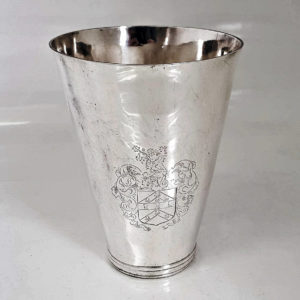
1637
Robert Gregory
9790 Charles I Silver Beaker
Sold
An early English silver beaker of unusual tapering form with a simple applied foot rim. Very plain style. Large size and good weight. To the front is a well executed armorial, hand engraved, the style is typical of the Charles I period with the shield surmounted by a crest and flowing mantling, The arms are for Dr Thomas Eden, Master of Trinity Hall, Cambridge. Contains 550 ml. Weight 279 grams, 8.9 troy ounces. Height 13.8cm. Diameter 10.5cm. Stamped on the rim for London 1637. Maker’s mark attributed to “possibly” Robert Gregory by David Mitchell in his Silversmiths in Elizabethan and Stuart London. Sterling silver.
-

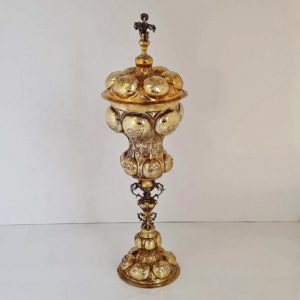
Circa 1640
9786 German Parcel Gilt Silver Cup & Cover
Sold
A rare and impressive antique silver standing cup and cover of baluster shape with lobed foot. Large size. The waisted, lobed body is chased with fleur-de-lys and scrolls on a finely matted background. The top has a silver vase of flowers finial. This form is typical of German Renaissance banqueting silver cups and the quality is excellent. Contains 500 ml. Weight 611 grams, 19.6 troy ounces. Height – 40 cm (total), 29.5 cm (cup). Diameter of top 10.6 cm. Stamped by the rim and on the foot with the German town mark “W” possibly Breslau. Makers mark “WO” unidentified. Circa 1640.